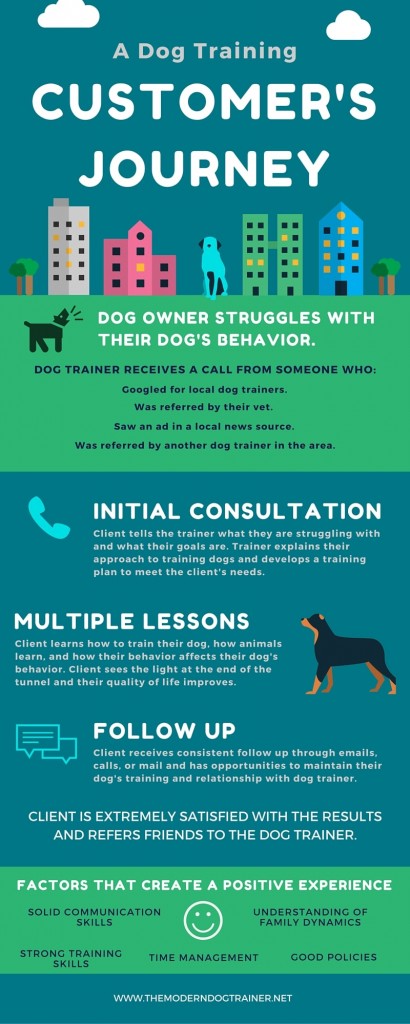When a prospective client calls you, it is unlikely that they know exactly what to expect. Usually, all they know is that they are in over their heads and they need professional help. Here we discuss the process a successful dog training guides their client through to create a satisfying customer journey.

Acquiring a Dog Training Client
Clients usually get your contact information through four main sources.
- Search Google for local dog trainers
- Their vet refers them to you after you’ve created a strong relationship with the vet.
- Advertising you have paid for in local news sources.
- Another trainer refers them to you if they are unqualified or don’t have time.
Initial Dog Training Consult
The client then goes through an initial consultation either on the phone or in person. This is where you gather as much information about their case as you can. During this consultation, you can develop a training plan that will suite the needs of the dog as well as the family’s situation. This takes a deep understanding of animal behavior training and setting realistic goals for this particular dog and family. Each family will require different environmental setups and each dog will learn in their own way. The more families you work with, the more you will expand your tools in your toolbox.
Several Lessons to Follow-Up
Several lessons are usually needed to make progress in any case. Rarely will one lesson solve an issue. Several lessons allow you to address other issues that may pop up and will allow you to make sure clients are implementing training techniques correctly. Client’s quality of life should improve quickly and they should start to see the “light at the end of the tunnel.”
Follow-Up After Dog Training Lessons
Most new trainers fail when it comes to this part of the client’s journey. (It is something I have done in the past due to lack of experience and understanding.) It is easy to complete lessons and then never initiate conversations with the client again once their problems are “fixed.” However, this is a huge missed opportunity! Maintaining a relationship with the client means you can offer them more services (and continue your income). They will maintain their dog’s training better in the long run. And, ultimately, you’ll stay fresh in their mind so when their friends complain about their dog’s behavior, they can quickly recommend you!
Many factors play a role in satisfying clients. Dog training is a challenging service because much of what contributes to the success of the dog’s training is out of your hands. You can make recommendations, but there is no way to quickly “fix” the dog without complete cooperation from the owner. Even then, many other factors contribute that are out of your control – genetics, history, environment, etc.
Factors that you CAN control include:
- Good communication & social skills
- Strong training skills/knowledge
- Understanding of family dynamics
- Good policies, time management, upholding your promises/appointments
- Follow up with client after lessons are complete
- Provide additional services for maintaining training for dog & relationship with owner
Being a successful dog trainer means being an ever-learning business owner so you can provide the ultimate experience for your customers. In the end, the most successful businesses have a lot of word of mouth referrals. What part of the dog training client’s journey do you need to improve? Share your thoughts in the comments below!
Get Dog Training Business Tips!
Receive valuable dog training business tips and resources every week! Subscribe to The Modern Dog Trainer now by submitting your name and email below.
[mc4wp_form]



